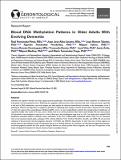Por favor, use este identificador para citar o enlazar a este item:
http://hdl.handle.net/10261/286790COMPARTIR / EXPORTAR:
 SHARE SHARE
 CORE
BASE CORE
BASE
|
|
| Visualizar otros formatos: MARC | Dublin Core | RDF | ORE | MODS | METS | DIDL | DATACITE | |

| Título: | Blood DNA methylation patterns in older adults with evolving dementia |
Autor: | Pérez, Raúl F. CSIC ORCID; Alba-Linares, Juan J. CSIC ORCID; Tejedor, Juan Ramón CSIC ORCID ; Fernández, Agustín F. CSIC ORCID; Calero, Miguel; Román-Domínguez, Aurorra; Borrás, Consuelo; Viña, José; Ávila, Jesús CSIC ORCID ; Medina, Miguel CSIC ORCID; Fraga, Mario F. CSIC ORCID | Fecha de publicación: | 2022 | Editor: | Oxford University Press | Citación: | Journals of Gerontology A - Biological Sciences and Medical Sciences 77(9): 1743-1749 (2022) | Resumen: | Dementia and cognitive disorders are major aging-associated pathologies. The prevalence and severity of these conditions are influenced by both genetic and environmental factors. Reflecting this, epigenetic alterations have been associated with each of these processes, especially at the level of DNA methylation, and such changes may help explain the observed interindividual variability in the development of the 2 pathologies. However, the importance of epigenetic alterations in explaining their etiology is unclear because little is known about the timing of when they appear. Here, using Illumina MethylationEPIC arrays, we have longitudinally analyzed the peripheral blood methylomes of cognitively healthy older adults (>70 year), some of whom went on to develop dementia while others stayed healthy. We have characterized 34 individuals at the prediagnosis stage and at a 4-year follow-up in the postdiagnosis stage (total n = 68). Our results show multiple DNA methylation alterations linked to dementia status, particularly at the level of differentially methylated regions. These loci are associated with several dementia-related genes, including PON1, AP2A2, MAGI2, POT1, ITGAX, PACSIN1, SLC2A8, and EIF4E. We also provide validation of the previously reported epigenetic alteration of HOXB6 and PM20D1. Importantly, we show that most of these regions are already altered in the prediagnosis stage of individuals who go on to develop dementia. In conclusion, our observations suggest that dementia-associated epigenetic patterns that have specific biological features are already present before diagnosis, and thus may be important in the design of epigenetic biomarkers for disease detection based on peripheral tissues. | Versión del editor: | https://doi.org/10.1093/gerona/glac068 | URI: | http://hdl.handle.net/10261/286790 | DOI: | 10.1093/gerona/glac068 | E-ISSN: | 1758-535X |
| Aparece en las colecciones: | (CINN) Artículos (CBM) Artículos |
Ficheros en este ítem:
| Fichero | Descripción | Tamaño | Formato | |
|---|---|---|---|---|
| bloodementia.pdf | 5,58 MB | Adobe PDF |  Visualizar/Abrir |
CORE Recommender
PubMed Central
Citations
7
checked on 28-abr-2024
SCOPUSTM
Citations
9
checked on 28-abr-2024
WEB OF SCIENCETM
Citations
10
checked on 28-feb-2024
Page view(s)
36
checked on 30-abr-2024
Download(s)
36
checked on 30-abr-2024

